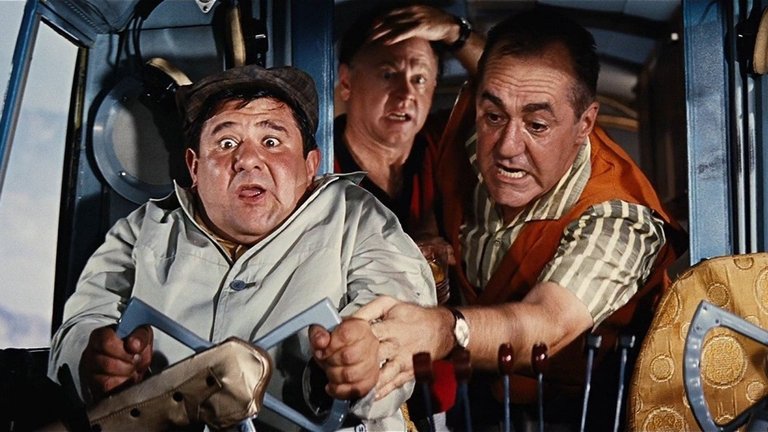
In the early 1960s, the United States stood at the pinnacle of global power and confidence, a sentiment that permeated various aspects of American life. This era was characterised by a penchant for bigness—from expansive landscapes and oversized automobiles to exaggerated cultural symbols, including women's breasts. Such grandeur naturally extended to the film industry, where the trend of creating epic films emerged, even within genres traditionally associated with shorter runtimes and modest budgets. Comedy, often relegated to smaller productions, found itself transformed into a spectacle of monumental proportions, culminating in Stanley Kramer's 1963 film It’s a Mad, Mad, Mad, Mad World. This film epitomised the era's obsession with excess and ambition in cinema.
The narrative unfolds on a California highway where Smiler Grogan (played by Jimmy Durante), an elderly criminal, meets his demise following a car crash. In his final moments, he divulges to a group of motorists the existence of $350,000 he had stolen fifteen years prior, hidden beneath a "Big W" in Santa Rosita State Park. This eclectic group includes Melville Crump (played by Sid Caesar) and his wife Monica (playeed by Edie Adams), who are on a second honeymoon; friends Ding Bell (played by Mickey Rooney) and Benjy Benjamin (played by Buddy Hackett) en route to Las Vegas; businessman J. Russell Finch (played by Milton Berle), his wife Emmeline (played by Dorothy Provine), and his overbearing mother-in-law Mrs. Marcus (played by Ethel Merman); along with delivery truck driver Lennie Pike (played by Jonathan Winters). When their attempts to negotiate a fair division of the treasure fail, each participant embarks on an individual quest for the loot. This leads to a chaotic treasure hunt filled with vehicular mayhem and slapstick antics, further complicated by characters such as motorist Otto Meyer (played by Phil Silvers) and British officer Lt. Col. J. Algernon Hawthorne (played by Terry-Thomas). Unbeknownst to them, they are being pursued by police led by Captain T. G. Culpeper (played by Spencer Tracy).
At its core, It’s a Mad, Mad, Mad, Mad World operates on a fundamentally simple premise: a treasure hunt that serves as an excuse for a series of action-packed scenes. The humour largely derives from physical comedy and slapstick rather than intricate dialogue or character development. This formula has been employed in numerous comedies throughout cinematic history, both successful and otherwise.
What distinguishes this film is its grand scale. It is one of the few productions made in the Cinerama widescreen format—albeit using a less complex single-camera method—and originally boasted an epic runtime exceeding three and a half hours before being trimmed to three hours for general release. The version restored in 2014 runs for 197 minutes but still contains certain black spots where sound is present without corresponding visuals.
The film's expansive scale is mirrored in its ensemble cast, which features some of the most beloved television comedians of the time—such as Berle, Caesar, and Silvers—as well as accomplished film actors like Terry-Thomas and Dick Shawn. However, Shawn's talents are somewhat squandered due to his late arrival in the film and underdeveloped characterisation. Additionally, It’s a Mad, Mad, Mad, Mad World includes numerous celebrities cameos, including silent Hollywood legends like Buster Keaton and Zasu Pitts, with Pitts receiving posthumous credit due to her passing shortly before the film's premiere.
The screenplay by William Rose and Tania Rose is functional but lacks depth or originality. The major plot twists—including those involving Captain Culpeper—are predictable for astute viewers. Many jokes feel repetitive; as is often the case with uninspired comedies, physical action compensates for the absence of sharp humour.
Despite these shortcomings in writing, Stanley Kramer—a filmmaker renowned for his politically charged dramas—manages to direct this comedic venture with relative success. He maintains an engaging pace throughout the film and effectively utilises the talents of his star-studded cast while leveraging a substantial budget for special effects and stunts. This combination generally succeeds in keeping audiences entertained.
It’s a Mad, Mad, Mad, Mad World was indeed a significant gamble for its time but ultimately reaped rewards by becoming one of the biggest hits of its era. However, the trend for grand comedies did not endure; audiences soon gravitated back towards musicals and period pieces as their preferred cinematic spectacles. Nevertheless, Kramer's film left an indelible mark on comedy cinema, serving as a template for subsequent films that sought to replicate its formulaic chaos—most notably seen in Million Dollar Mystery, which emerged roughly twenty-five years later.
It’s a Mad, Mad, Mad, Mad World embodies both the excesses and ambitions of American cinema during the early 1960s while simultaneously reflecting broader cultural themes of greed and competition inherent in society at that time. While it may not be universally acclaimed for its script or character development, its sheer scale and energetic performances ensure it remains an enduring piece of cinematic history—a testament to an era when bigger truly was better in Hollywood's eyes.
RATING: 6/10 (++)
Blog in Croatian https://draxblog.com
Blog in English https://draxreview.wordpress.com/
InLeo blog https://inleo.io/@drax.leo
Hiveonboard: https://hiveonboard.com?ref=drax
InLeo: https://inleo.io/signup?referral=drax.leo
Rising Star game: https://www.risingstargame.com?referrer=drax
1Inch: https://1inch.exchange/#/r/0x83823d8CCB74F828148258BB4457642124b1328e
BTC donations: 1EWxiMiP6iiG9rger3NuUSd6HByaxQWafG
ETH donations: 0xB305F144323b99e6f8b1d66f5D7DE78B498C32A7
BCH donations: qpvxw0jax79lhmvlgcldkzpqanf03r9cjv8y6gtmk9